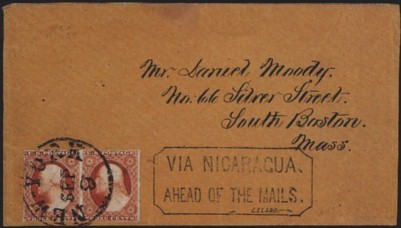

L is for Local Stamps |

|

|

|

|

A Local stamp is any postage stamp created by a local, private mail-carrying entity (as opposed to a national postal service).
Prior to about 1845, US mail service operated only between post offices - individuals (and businesses) were required to collect their mail from the PO serving them. Private companies (similar to today's bicycle messengers), which came to be called "local posts", offered pickup and delivery within larger cities, and some of them created their own stamps to show payment of fees. By the 1860's this practice had died, as the USPOD expanded its services - indeed, Congress passed laws making Local posts illegal, to eliminate their competition with the Post Office.
There are still a few local posts in the US, in remote areas where delivery is too random or difficult for government service. Collection and study of early locals is a popular sideline among philatelists, who prize especially covers bearing both a valid Local stamp and a US stamp. Related topics include Agents, Provisionals,Carriers, Expresses, and Forwarders.
Rest your mouse cursor over an image, and if it changes to a hand, clicking there will bring up a larger high-res version.
Some typical Local Stamps of the mid-1800's



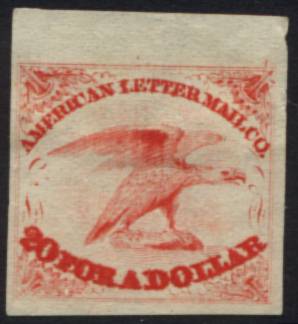
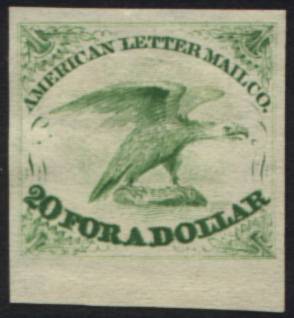
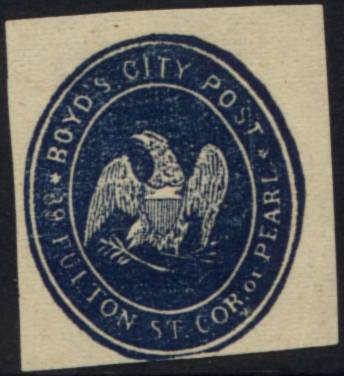
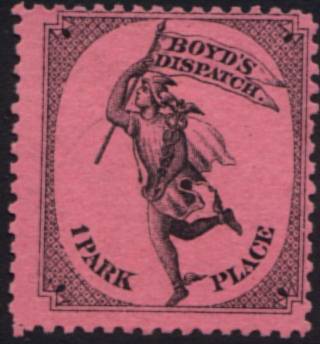


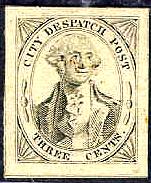
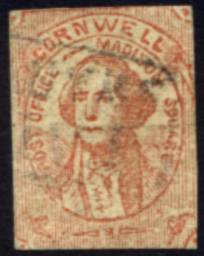
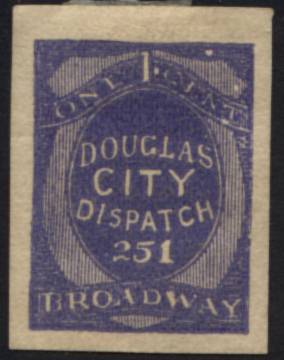
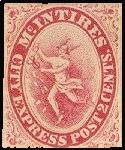
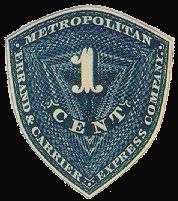

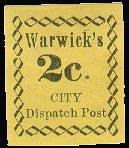
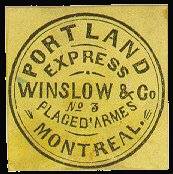

One does not collect Locals for their beauty or color - the ones above are
among the
more elaborate and attractive designs; moreover, some of these are undoubtedly
reprints,
reproductions or fakes, as legitimate items are far scarcer than fakes. Most
locals were
simple text labels, poorly printed, imperforate and carelessly separated.
Their appeal
is in their importance to the story of the development of the mails in the US,
combined
with the scarcity of good material.
11/09/2017 - Collector Paul Dessau informed me that the stamp below is a fake - "Kers City Post ... was a fake, created by a 19th century dealer. There was no such local post." Thanks, Paul.
Local on Cover

Locals on cover that can be authenticated as valid uses are especially prized,
as the
area abounds with bogus material, and most locals were either not cancelled at
all, or
their cancels do not tie them to the cover. The one above exemplifies the
most desirable
usage - with a Boyd's City Express stamp, it was carried both locally and via
the
government mails, as indicated by the "5 cts" in the handstamp plus the 2cts
of the
Boyd's stamp. This cover probably dates from 1848, when the use of government stamps to prepay mail was still not
compulsory,
which explains the handstamp. Boyd's, in New York City, was the largest and
longest-
lived of all the locals. The fact that the stamp is on an attractive
Valentine cover
adds to its value as well - this cover sold for $1870 in 1996.
Pony Express

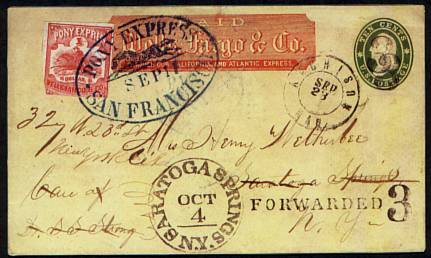
The term "Local" is often used loosely to include as well the Carriers and
Express
services, since all of them were a part of the same era, and performed
services that
supplemented the government mail service. The Pony Express, whose lifetime was
surprisingly short - a mere nineteen months, from April, 1861 to October,
1862, when
completion of the first transcontintental telegraph line put it out of
business -
symbolizes an exciting, often romanticized period of our history, and the
expansion
Westward. Valid Pony Express covers like the two above, with Wells Fargo
adhesives and
attractive, authentic handstamps, are scarce and valuable - these two sold
recently for
$11,000 and 18,700, respectively.
Via Nicaragua, Ahead of the Mails
This cover is a personal favorite (though I own only a photograph from a Siegel auction catalog), because of the handstamp - Via Nicaragua, Ahead of the Mails. It dates from around 1855 (based on the stamps), before completion of the first trans- continental railroad in 1869. The fastest way to send a letter from San Francisco, where this originated, to the East Coast, was via an Express company, on a steamship down the West coast to Nicaragua, across the isthmus via mule and train to the Gulf of Mexico, and then via steamship up the US coast to the Northeast! I've no idea how long either journey took, but it must have been several months; and the idea that it was faster via Nicaragua amazes me, as well as the fact that completion of the Transcontinental Railroad cut the travel time to less than a week. (The Scott US Specialized catalog shows this handstamp in the section titled "Local Handstamped Covers", under the heading "Accessory Transit Co. of Nicaragua".)
By the way, the building of the Trans-Continental Railroad in the US is a
fascinating
chapter in American History - an Internet search on the topic will yield you
hours of
interesting reading and viewing. You may know that the line was built by two
separate
companies, working from opposite sides of the country. But did you know they
SHOULD
have met weeks earlier than they did, and were
preparing to lay parallel
tracks (they created parallel grades, but never got as far as the actual
tracks),
because the government had granted them money (and land) per mile of track
laid, with no stipulation that they ever had to meet? It took a special act
of Congress
to force the final meeting at
Promontory Summit, Utah, on May 10, 1869.
Modern Locals
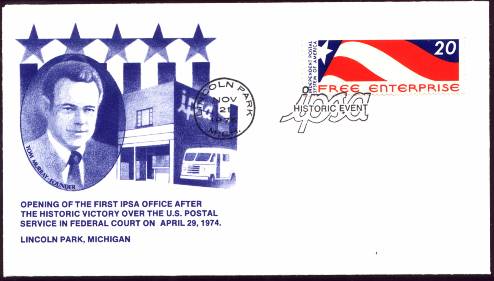
The Independent Postal System of America was a short-lived effort to establish a
local/private post in the US in the 1970's. Its founder won a legal battle
with the USPS
and gained permission to pursue his business, but then failed shortly
afterwards, partly
because of the huge legal costs. He probably deserves some credit for the
subsequent
success of organizations like Federal Express.
Modern Locals
A few modern local posts have existed, in remote areas the USPS does not serve. One is Rattlesnake Island, Ohio, in southwestern Lake Erie (about twenty miles north-west of Sandusky), which gets its mail service via a private plane. From 1966 to 1989, the carrier created his own stamps and postmarks, which some collectors pursue.
The most delightful episode of the history of Rattlesnake Island Local Post
occurred in
1967, when The Huntley-Brinkley Report, a popular TV news show of the day, did
a spot
about the carrier's initial difficulties getting USPS approval for his stamps
and
cancels, casting the island's owners as David fighting Goliath. The spot was
picked up
by Budapest TV, which turned the story into a fantasy about modern American
revolutionaries fighting their capitalist oppressors (Hungary was under
Communist control
at the time), with the bizarre result that the island received CARE packages
from Hungary
for several months! Keep in mind that the owners at the time were a group of
doctors and
stockbrokers who bought it for a vacation retreat. (Thanks to Carl Klosinski
and Bob
Fritz for the full story of RILP.)
| Home | K is for Kansas City Roulettes <<< | Contents | >>> M is for Mulready Envelope | Credits |
All Letter images Copyright © 1997, 2000, SF chapter of AIGA
All text Copyright © 2000, William M. Senkus
Send feedback to the webmaster: CLICK HERE
Revised -- 11/09/2017

